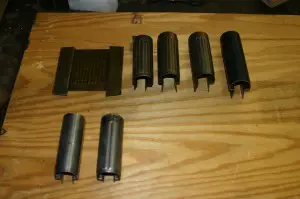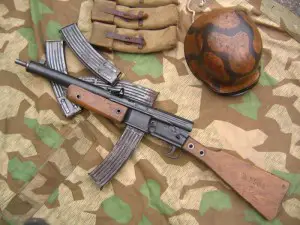Fascinating project at GunLab and Weaponeer
There are projects and there are projects.
This one deserves the italics. Chuck Kramer is an 07 FFL (that’s a manufacturer) and 02 SOT
(special occupational taxpayer, means he can make NFA stuff). He’s also pretty creative around a metal shop, to include machine tools, sheet metal work, and welding. All of those skills are going to be necessary, because he’s building a replica of the Gustloff VG 1-5.
If you don’t know what that is, go over to Ian’s place for a how-it-shoots video, and/or read this overview on Weaponeer, then come back (or go to Chuck’s build threads).
He has other ambitions — he’s worked out, for example, that an MP-44 lower receiver requires 60 operations to produce — but his first task is to build a VG 1-5. He’s not absurdly committed to originality — for example, he’s already improved the Heath Robinson trigger mechanism of the original — but he’s using processes remarkably close to the cottage workshop techniques used in the original, a last-ditch Volkssturm weapon produced in 1945 as Russian, American, British and French forces were squeezing the Third Reich like four angry anacondas.
So far, he’s built the lower receiver and is working on the receiver cover, both of which require metal pressing, cutting, and welding skills. He had to take a break whilst installing new digital readouts (DROs) on his lathe.
One more thing…
The DRO’s are important because Chuck’s not just building one of these. He’s planning to build sixty. Are you in line yet? (We expect they will be NFA Short Barrel Rifles). Sorry, New York — it’s expected to come with a 10-round mag. It won’t be available in North Korea or Cuba, either.
There are two essential sources:
GunLab is where Chuck will post deeper explanations and videos, in conjunction with Ian of ForgottenWeapons.com and GunLab.net. The first couple are already up:
- Part 1 introduces the project and sets up the series. There are images of computer 3D models and a cutaway of the original firearm.
- Part 2 examines how the receiver pressings are made, with Ian hosting a video. This really combines well with the Weaponeer thread (linked below) to ensmarten one on how small shops can press fairly complex sheet metal shapes without million-dollar presses and $10k’s in tooling per part.

Stamping Evolution: a single stamped flat, with several versions of the shaped but unwelded/machined receiver cover — all but one an evolutionary dead end.
Of course, the pressings != receiver by themselves. There is quite a bit of cutting, fitting, welding and machining before the raw stampings are an actual receiver.
The Weaponeer thread describes his processes, his progress, and his learning curve. (There is as much art as science to die-pressing sheet steel, it turns out). He can post stills here, but not videos.
So the GunLab.net and Weaponeer versions of the story combine to inform you. GunLab has a much higher signal to noise ratio, but some of the commenters at Weaponeer (same as at GunLab or Forgotten Weapons) are really well-informed, and interesting things come out in the comments if you have the patience to read them.
3 thoughts on “Fascinating project at GunLab and Weaponeer”

Kevin was a former Special Forces weapons man (MOS 18B, before the 18 series, 11B with Skill Qualification Indicator of S). His focus was on weapons: their history, effects and employment. He started WeaponsMan.com in 2011 and operated it until he passed away in 2017. His work is being preserved here at the request of his family.


Pingback: Fascinating project at GunLab and Weaponeer | The Gun Feed
More specifically, he is a Class 2 SOT. Class 1 and Class 3 SOT can’t manufacture NFA items. Class 1 SOT can import and sell NFA items, and Class 3 SOT are merely dealers of NFA items.
Updated. Thanks (as ever) Dan. And yes you were right about the revolver, looks like a Colt (detective special, perhaps), and the Glock (its frame checkering pattern is a match for my G3 G17). Excellent catch on the absence of the forestrap strain screw characteristic of Smiths.